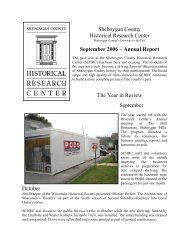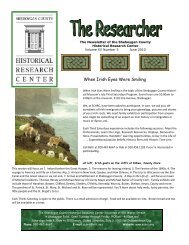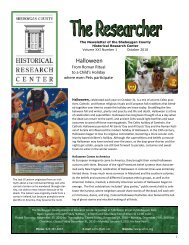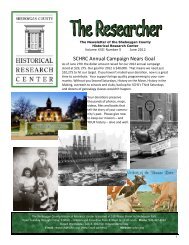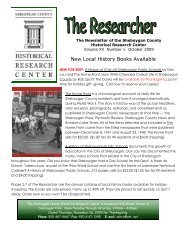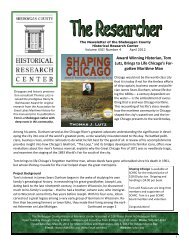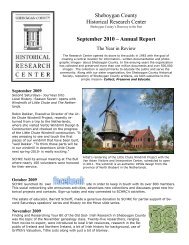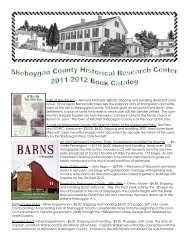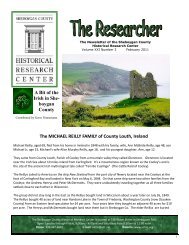Shadow of the Phoenix - Sheboygan County Historical Research ...
Shadow of the Phoenix - Sheboygan County Historical Research ...
Shadow of the Phoenix - Sheboygan County Historical Research ...
Create successful ePaper yourself
Turn your PDF publications into a flip-book with our unique Google optimized e-Paper software.
Excerpt from PLOUGHS AMONG THE ESKERS<br />
A story <strong>of</strong> <strong>the</strong> settlement <strong>of</strong> <strong>the</strong> Kettle Moraine<br />
By Bernard Michaels<br />
The Thomas and Mona Scanlan Heraty family standing in front <strong>of</strong> <strong>the</strong>ir cream city brick<br />
home. The homestead was located on <strong>County</strong> Highway V about one-half mile south <strong>of</strong> Hwy<br />
67 in <strong>the</strong> town <strong>of</strong> Mitchell. Heraty was an influential part <strong>of</strong> early immigrant life in <strong>the</strong> area<br />
known as “The Kettles”, acting as an insurance agent, justice-<strong>of</strong>-<strong>the</strong>-peace and postmaster.<br />
The Irish came to <strong>the</strong> Kettles<br />
poorly equipped to begin farming<br />
in <strong>the</strong> wilderness. Land buying<br />
had all but exhausted <strong>the</strong>ir meager<br />
funds and now <strong>the</strong>y were faced<br />
with <strong>the</strong> expense <strong>of</strong> outfitting.<br />
Common to <strong>the</strong> era, equipment<br />
prices were high in <strong>the</strong> frontier<br />
villages. In <strong>Sheboygan</strong> a yoke <strong>of</strong><br />
oxen sold for between fifty-five<br />
and sixty dollars, a wagon brought<br />
fifty-four dollars, cows were sixteen<br />
dollars a head, a plow cost<br />
ten dollars and a harrow, four dollars.<br />
Many settlers walked to <strong>the</strong>ir<br />
Kettle "holdings" carrying little<br />
more than an axe and grub hoe<br />
with which to establish <strong>the</strong>ir new<br />
livelihood.<br />
The first recorded Irish settler<br />
was Dan Murphy who settled on<br />
section 18 in 1846. He was followed<br />
by <strong>the</strong> John O'Reilly family,<br />
lately <strong>of</strong> <strong>County</strong> Meath, who<br />
settled on <strong>the</strong> town line <strong>of</strong> Scott<br />
and Mitchell in <strong>the</strong> fall <strong>of</strong> 1847.<br />
They were joined <strong>the</strong> following<br />
year by Michael and Ann Murray who "took land" east <strong>of</strong> Butler Lake. Within a decade, a hundred families from <strong>the</strong><br />
"Old Sod" had ga<strong>the</strong>red among <strong>the</strong> eskers and kames <strong>of</strong> <strong>the</strong> area. By 1860 those parts <strong>of</strong> Scott, Mitchell, and Osceola<br />
included by today's forest boundaries had become an Irish enclave.<br />
In 1854, <strong>the</strong> settlement built a log church on a small hilltop <strong>of</strong> section twenty-one. The Congregation <strong>of</strong> St.<br />
Michaels was served by a circuit-riding priest until being assigned its first pastor in 1859. The rapid influx <strong>of</strong> Irish settlers<br />
soon gave need for a larger church and in 1861, <strong>the</strong> timber-frame structure serving today's parish was completed.<br />
The wea<strong>the</strong>red inscriptions in <strong>the</strong> churchyard cemetery provide <strong>the</strong> origin <strong>of</strong> many <strong>of</strong> its early members. While <strong>the</strong> Gaelic<br />
place-names represent all corners <strong>of</strong> Ireland, most are from <strong>the</strong> counties west <strong>of</strong> <strong>the</strong> River Shannon, <strong>the</strong> region affected<br />
most severely by <strong>the</strong> famine.<br />
Although many <strong>of</strong> <strong>the</strong> Irish migrated to <strong>the</strong> Kettles in family sized units, two mass arrivals to <strong>the</strong> region also occurred<br />
during <strong>the</strong> 1850s. One <strong>of</strong> <strong>the</strong>se was a group <strong>of</strong> fifteen families from New York state who had been previously<br />
engaged in digging canals in that area. Settling on adjacent holdings along <strong>the</strong> east shore <strong>of</strong> Long Lake, <strong>the</strong>y included<br />
such names as Quinn, Franey and Gilboy. In 1857, a crew <strong>of</strong> Irish laborers, with <strong>the</strong>ir families, was brought into <strong>the</strong><br />
nor<strong>the</strong>rn Kettles to build <strong>the</strong> <strong>Sheboygan</strong>-Mississippi Railroad. When rail construction was temporarily halted for a year,<br />
<strong>the</strong> workers were forced to turn to <strong>the</strong> land for survival, some finding work with farmers, o<strong>the</strong>rs buying land <strong>of</strong> <strong>the</strong>ir<br />
own. Later when <strong>the</strong> railroad was finally completed, many <strong>of</strong> <strong>the</strong>se people remained in <strong>the</strong> community.<br />
The Irish immigrants brought to <strong>the</strong> community <strong>the</strong>ir love <strong>of</strong> social ga<strong>the</strong>rings, music, dancing and just plain<br />
"visiting" which even <strong>the</strong> tragedy <strong>of</strong> <strong>the</strong> famine had not diminished. More than any o<strong>the</strong>rs <strong>the</strong>y showed a preference for<br />
working in groups. As settlers in <strong>the</strong> moraine area, <strong>the</strong>y raised <strong>the</strong>ir buildings, cleared <strong>the</strong> land and picked <strong>the</strong> everpresent<br />
stones with <strong>the</strong> help <strong>of</strong> <strong>the</strong>ir neighbors. These community work ga<strong>the</strong>rings <strong>of</strong>ten numbered scores <strong>of</strong> men, many<br />
6



